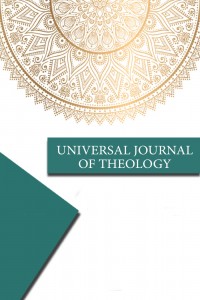“The Qur'an-Science Relations Throughout History and A Linguistic Analysis of the Qur'an-Science Relationship in the Context of Scientific Discoveries”
Öz
The relation between religion and science is the most controversial issue today as it was in the past. Many of the scholars refer in these debates to Christianity by religion. One of the main reasons for the tension between Christianity and science is that the Christian holy books contain doctrines contradicting the results of positive sciences. the negative attitude of the Catholic Church towards science during the middle ages was criticized. Moreover, some scholars considered the past as the conflict arena between the science and religion.
The negative attitude of medieval Catholicism towards Copernicus’s scientific discovery and trial of Galileo, who supported Copernicus were the most known examples that symbolized the tension of science and religion.
In Islamic history, this kind of tension between science and religion has not been witnessed. In the Islamic world, even rational materialist philosophers such as Ibn al-Ravendi and Abu Bakr al-Razi cannot be said to have been subject to severe punishments, torture and constant prosecution. Therefore, it cannot be said that the religion-science tension observed in the Christendom is also experienced in the Islamic world. This was, above all, due to the positive attitude of the Islam's holy book, the Qur'an, against science and scientific thought.
It is seen that the Qur'an going further points out by different contexts in a very special language to some scientific facts, which have only been discovered and known in detail today. It is known that not only the Arabs of Jahiliyya pre Islam but also the philosophical and scientific background of the age is much far beyond the discovery of these realities. These natural realities could only be discovered by modern scientific studies.
So, Muslim scholars have never been shy against science. On the contrary, they received everything they found in ancient civilizations in terms of scientific thought. İn this way, they have transferred the scientific and intellectual heritage of all the great civilizations such as Iran, Byzantine, Greek, Egypt and Indian to the Islamic world in a very short time.
In the work, the relationship between the Qur'an and scientific thought and its historical projections will be discussed and evaluated. In addition, the linguistic subtleties of the Qur'an in the Cahiliyya era, which reflect a profoundly scientific sense, will be discussed through two most striking examples of its linguistic uses that go beyond the ages.
Anahtar Kelimeler
Kaynakça
- Akun, Omer Faruk, “Nâmık Kemal”, DİA, İstanbul 2006, XXXII, 375.
- al-Imam al-Gazzali, Tehafutu’l-Felasife, ed. Suleyman Dunya, Cairo: Dar al-Maarif 1385/1966.
- Aydin, Mehmet, Din Felsefesi, 5th edition, Ankara 1996.
- Baljon, J. M. S., Modern Muslim Koran interpretation (1880–1960), Leiden: E.J. Brill, 1961.
- Brown, H., The Wisdom of Science; Its Relevance to Culture and Religion, Cambridge 1986.
- Çelebi, Katip, Mizanu’l-Hak, İstanbul 1972.
- Daştan, Cafer, Ortaöğretim 10. Sınıf Biyoloji Ders Kitabı, Ankara 2017, p. 81.
- İbn Rushd, Faslu’l-Makaal, İstanbul 1986.
- Jansen, J. J. G., The Interpretation of the Koran in Modern Egypt, Leiden: E.J. Brill 1980.
- Kırca, Celal, Kur’ân ve Bilim, İstanbul 1996.
- Kırca, Celal, Kur’ân-ı Kerim’de Fen Bilimleri, İstanbul 1989
- Kurtubi, Abu Abdullah Muhammad b. Ahmed al-Kurtubi, al-Cami li Ahkamu’l-Qur'an, ed. Hisham Semir al-Bukhari, I-X, Riyadh: Daru Alemi’l-Kutub 1423/2003.
- Muhamed Fuad Abdulbaki, el-Mu’cemu’l-mufehres li elfazi’l-Qur’ani’l-Kerim, Cairo: Daru’l-Kutubi’l-Mısriyye 1945.
- Muhammad at-Tahir b. Ashur, et-Tahrir ve’t-Tenvir, I-XXX, Tunus 1984.
- Newton, Isaac, An Historical Account of Two Notable Corruptions of Scripture, London 184).
- Nureddin es-Sabuni, al-Bidaye fi fi usuli’d-diyane, ed. Bekir Topaloglu, Ankara 1979.
- Ragıb el-Isfehani, Mufredatu elfazi’l-Qur’an, ed.. Safvan Adnan Davudi, nd.
- Razi, Fahrettin Muhammad b. Omar er-Razi, Mefatihu’l-Gayb, I-XXXII, Beirut: Daru İhyai’t-Turasi’l-Arabi 1420.
- Suyuti, Abdurrahman b. Kemal Celaluddin es-Suyuti, ed-Dürrü’l-mensûr fi’t-Tefsir bi’l-Me’sur, I-VIII, Beirut: Darü’l-Fikr 1993, V, 73-74.
- Taberi, Abu Jafar Muhammad b. Cerir et-Taberi, Camiu’l-beyaan fi ta’vili aayi’l-Qur'an, ed. Ahmed Muhammed Şakir, I-XXX, Muesseset ar-Risale, 1420/2000,
- Taylan, Necip, “Bilgi”, DİA (Türkiye Diyanet Vakfı İslam Ansiklopedisi), İstanbul 1992, vol. VI, p. 158-159.
- Yılmaz, İrfan et. al., Yeni Bir Bakış Açısıyla İlim ve Din, I-II, İstanbul 1998.
- https://kuranmucizelericilt1.wordpress.com/tag/asilayici-ruzgarlar/ (Access Date 21.05.2019)
Ayrıntılar
| Birincil Dil | Türkçe |
|---|---|
| Bölüm | Araştırma Makaleleri |
| Yazarlar | |
| Yayımlanma Tarihi | 31 Aralık 2020 |
| Gönderilme Tarihi | 23 Kasım 2020 |
| Kabul Tarihi | 30 Aralık 2020 |
| Yayımlandığı Sayı | Yıl 2020 Cilt: 5 Sayı: 2 |

